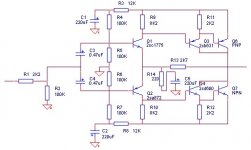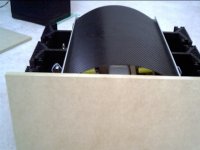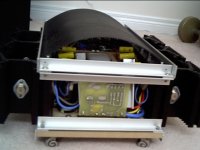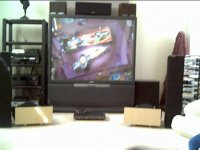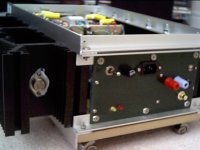Heatsink?
I bought the heatsinks from RScomponent (UK) part number 401-958. A dozen of them is needed.
160 watts of power dissipation per channel? What are you using for heatsinks?
I bought the heatsinks from RScomponent (UK) part number 401-958. A dozen of them is needed.
Full of it vessels, plenty
Face plate removed, the pcb in the front is the soft start circuit, does not work yet, capacitor as resistor value is too high so the relays are not working without power. Too scare to ask basic questions in this forum, too many full of it around, ops, forget to keep quiet, sorry.
Face plate removed, the pcb in the front is the soft start circuit, does not work yet, capacitor as resistor value is too high so the relays are not working without power. Too scare to ask basic questions in this forum, too many full of it around, ops, forget to keep quiet, sorry.
Attachments
Thijs,
I use 4 MJ15003 in the amp and 2 LM338K in the PSU. The voltage drop across R9 is 194mV so I say it is close to 4 amps, and the amp is so stable I get 00.5 displayed on my multi-meter set at 200mV on the dial when test for the DC offset. The switch on DC offset is around 480mV and start trimming right away. It does take an hour to get down to 0.5mV though. It did not sound as good when bias setting is lower.
I use 4 MJ15003 in the amp and 2 LM338K in the PSU. The voltage drop across R9 is 194mV so I say it is close to 4 amps, and the amp is so stable I get 00.5 displayed on my multi-meter set at 200mV on the dial when test for the DC offset. The switch on DC offset is around 480mV and start trimming right away. It does take an hour to get down to 0.5mV though. It did not sound as good when bias setting is lower.
what's transformer size you guys recommend for 4amps at 20 volts. is 250va 18 volt good enough.
is there much difference in sound when comparing regulated supply with 30000uf and the regulator with pi-filter(
22000uf - 15mh-144000uf)
when running at 4 amps won't the sinks be hot. The ratings for your sink is 0.5 rite. I used the same amount, 4 transistor on 4 sinks each 0.5 rating the temperature reaches 57 celcius at 22 volts at 2.2 amps. i was wondering to upgrade it to 4 amp soon so just wondering on the need for more sinks.
is there much difference in sound when comparing regulated supply with 30000uf and the regulator with pi-filter(
22000uf - 15mh-144000uf)
when running at 4 amps won't the sinks be hot. The ratings for your sink is 0.5 rite. I used the same amount, 4 transistor on 4 sinks each 0.5 rating the temperature reaches 57 celcius at 22 volts at 2.2 amps. i was wondering to upgrade it to 4 amp soon so just wondering on the need for more sinks.
The transformer I am using is Piltron 300VA 18-0-18, it gets rather hot after an hour or so the metal mounting disc of the transformer is too hot even to touch, the heat sinks are fine though, I can touch them for a long while without feeling uncomfortable. But I have no means to measure the temperature of the heatsink, actually my wife suggested that I should try to see whether it can make toast for her by place a slice of bread on top of each heatsink.
I am also interested to see what result/difference you may experience with the pi-filter too. My experience with more caps results in stronger bass but loses dynamic and air of the highs.
I am also interested to see what result/difference you may experience with the pi-filter too. My experience with more caps results in stronger bass but loses dynamic and air of the highs.
to test the the temperature using your fingers
bewarn keep a burn kit nearby
if the sink is to hot to touch 65 and above, u can't differentiate between 65 and 100 degress respond of the fingers will be faster the time taken for the finger's heat sensors to respond
if the sink is hot but the your hand is able to rest on it for a while, means temperature is less than 65 but more than 50
and i don't think we need to go more than that. class A should idle at 60 degrees to maximise heatsink cost
for more temperature ranges, u got to work at starbucks (steaming milk)
that why i can guess the temp with some tolerance plus i have a thermometer for food.
from your description the tranies at above 65. How fast does your hand respond by pulling away. Normally i guess the transformer can be run at almost maximum capacity with no much problem just less life for the tranies
but sinks are 50 to 57 should be okay
:
bewarn keep a burn kit nearby
if the sink is to hot to touch 65 and above, u can't differentiate between 65 and 100 degress respond of the fingers will be faster the time taken for the finger's heat sensors to respond
if the sink is hot but the your hand is able to rest on it for a while, means temperature is less than 65 but more than 50
and i don't think we need to go more than that. class A should idle at 60 degrees to maximise heatsink cost
for more temperature ranges, u got to work at starbucks (steaming milk)
that why i can guess the temp with some tolerance plus i have a thermometer for food.
from your description the tranies at above 65. How fast does your hand respond by pulling away. Normally i guess the transformer can be run at almost maximum capacity with no much problem just less life for the tranies
but sinks are 50 to 57 should be okay
:
voltage at minus side output cap
I've build the JLH 10W (1969) version as described in the 1996 article. (4 channels, 4 transformers, 4 bridges etc, 1 casing).
(figure 1 in http://www.gmweb.btinternet.co.uk/jlh1996.htm)
So far progress is slow but steady. (Thanks again to Geoff for the earthing problem.)
But I've encounterd the following problem and I was hoping for some help.
Last night when I finally was able to bi-amp the loudspeakers, everything seemed to be allright. Bi-amping sounds even better than normal amping.
But............, the sound from the right channel has a strange scratching, resonating component.
The only strange thing that I can find, is that the output (minus) side of the output cap has about 14V, seems to me that this shouldn't be so. (I expected 0V) I don’t know what causes this.
I have neglected to put a 1K resistor, after the ouput cap and earth, but can this be the problem or is it something else?
Luuk Boessenkool
I've build the JLH 10W (1969) version as described in the 1996 article. (4 channels, 4 transformers, 4 bridges etc, 1 casing).
(figure 1 in http://www.gmweb.btinternet.co.uk/jlh1996.htm)
So far progress is slow but steady. (Thanks again to Geoff for the earthing problem.)
But I've encounterd the following problem and I was hoping for some help.
Last night when I finally was able to bi-amp the loudspeakers, everything seemed to be allright. Bi-amping sounds even better than normal amping.
But............, the sound from the right channel has a strange scratching, resonating component.
The only strange thing that I can find, is that the output (minus) side of the output cap has about 14V, seems to me that this shouldn't be so. (I expected 0V) I don’t know what causes this.
I have neglected to put a 1K resistor, after the ouput cap and earth, but can this be the problem or is it something else?
Luuk Boessenkool
To boessenkool
hei boessengkool !
If you have 14 volts at the minus side of the output capacitor with the speaker conected...you a have a short in the capacitor and maybe a burned speaker!!!...
If the 14 volts reading is without the speaker conected is because, as you dont have put the 1k resistor the capacitor d'ont have a path to ground for charging...in this case everithing is fine...
Put the 1k resistor and measure again...
Regards
Jorge Santos
hei boessengkool !
If you have 14 volts at the minus side of the output capacitor with the speaker conected...you a have a short in the capacitor and maybe a burned speaker!!!...

If the 14 volts reading is without the speaker conected is because, as you dont have put the 1k resistor the capacitor d'ont have a path to ground for charging...in this case everithing is fine...
Put the 1k resistor and measure again...
Regards
Jorge Santos
Hei Santos !
Jorge,
I did have 14V at the speakers, but nothing happened.
Goes to show how good Dynaudio really is, it's a pity that the don't sell their components anymore.
I did put in the 1K resistor and indeed everything is ok now.
It is truly amazing what bi-amping can do. And that with an amplifier design from 1969.
Next stage for me: active crossover.
Luuk Boessenkool
Jorge,
I did have 14V at the speakers, but nothing happened.
Goes to show how good Dynaudio really is, it's a pity that the don't sell their components anymore.
I did put in the 1K resistor and indeed everything is ok now.
It is truly amazing what bi-amping can do. And that with an amplifier design from 1969.
Next stage for me: active crossover.
Luuk Boessenkool
NickC,
Sorry I lied, the transformer I am using is 300VA 22-0-22 not 18-0-18 as stated previously.
I used the variac to bring the amp up slowly and monitor the components and the heat along the way, so I get a rough idea what gets hot and what not in the first place. Most of the time people get burn is the unexpected contact, like I tend to burn myself when I change hands with the soldering iron, just grab the metal part of the iron instead by mistake.
How is your project coming?
Bosssenkool,
When you bi-amp without a cross-over (on the way I know) for now, don'you get overlap of certain frequency range between the Hi and Low, assuming you have not remove the passive crossover network in your speakers, so you are really bi-wire with two amps? If it has no problem then why one need to go the extra step to go active crossover?
Regards,
Chris
Sorry I lied, the transformer I am using is 300VA 22-0-22 not 18-0-18 as stated previously.
I used the variac to bring the amp up slowly and monitor the components and the heat along the way, so I get a rough idea what gets hot and what not in the first place. Most of the time people get burn is the unexpected contact, like I tend to burn myself when I change hands with the soldering iron, just grab the metal part of the iron instead by mistake.
How is your project coming?
Bosssenkool,
When you bi-amp without a cross-over (on the way I know) for now, don'you get overlap of certain frequency range between the Hi and Low, assuming you have not remove the passive crossover network in your speakers, so you are really bi-wire with two amps? If it has no problem then why one need to go the extra step to go active crossover?
Regards,
Chris
- Home
- Amplifiers
- Solid State
- JLH 10 Watt class A amplifier

